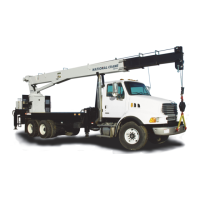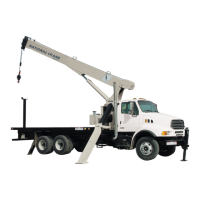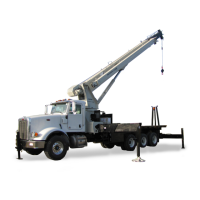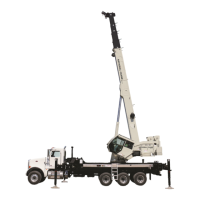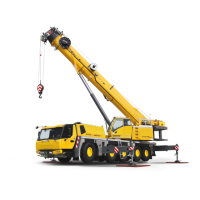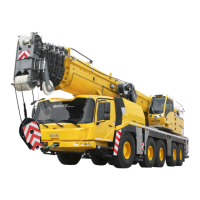2-4
&34$$&536%4$&
$#$%6$$&6&(')$7
83'$3$&)$69'
'3'6$3$&$$537
$$&6&8
If the operator cannot see the load handling device
approaching the boom nose, he shall have an assistant
(signal person) watch the load handling device. The
operator shall be prepared to stop the machine immedi-
ately should the LMI (or optional HCA system) not func-
tion properly. If the LMI (or optional HCA system) is not
functioning properly, lifting the anti-two-block weight will
not activate the red warning light or the audible alarm
(optional for the HCA system), and will not lock the crane
movements hoist up, telescope out, and boom down.
Check the anti-two-block alarm light and the audible
alarm by performing one of the following tests:
• Manually lift the weight attached to the anti-two-
block switches. When the weight is lifted, the
audible alarm for the LMI (or optional audible
alarm for the optional HCA system) should sound
and the anti-two-block alarm light should light.
• Slowly raise the main boom load handling de-
vice to create a potential two-block condition.
When the load handling device lifts the weight,
the audible alarm should sound, the anti-two-
block alarm light should light and the motion of
the load handling device should be stopped.
Lower the load handling device slightly to elimi-
nate this condition.
• Slowly extend (telescope) the boom to create a
potential two-block condition. When the load
handling device lifts the weight, the audible alarm
should sound, the anti-two-block alarm light
should light and the boom telescope out func-
tion should be stopped. Lower the load handling
device slightly to eliminate this condition.
3$&&$%'%56%$3'$
%5%%$&6#6$$
$%;$&)$6$4<) 8&
63'$&5$%53$$&
8
• If the crane is equipped with a boom extension
that is deployed and rigged for work, repeat the
test procedure for the boom extension anti-two-
block switch.
=!!>
All members of the crew should become thoroughly
familiar with the location and operation of controls, the
correct operating procedure, the maximum lifting ca-
pacities and the safety precautions applicable to the unit
before operating. This crane is a complex piece of equip-
ment and can be overloaded in many ways. Carefully
follow the operating procedures outlined below and in
the instructional pages of the load rating chart at the
operator’s station.
=!+,
Perform the following checks prior to placing the unit
in operation:
• Inspect for any unusual conditions such as pools
of hydraulic fluid or lubricating oil under the chas-
sis, any outrigger which may have crept down or
up and any signs of damage or improper main-
tenance.
• Check that the tires are inflated to the proper
pressure.
• Check the level of the hydraulic reservoir.
• Check the operation of the “stop” and horn cir-
cuits.
• Check for missing and loose bolts.
• Check for damaged structural members and
welds.
• Check all rope guides and cable keepers.
• Check all sheaves for free turning.
• Check the loadline cable for kinks, broken
strands or other damage in accordance with in-
structions in the “Lubrication & Maintenance”
section.
• Check to see that the hydraulic hoses and fit-
tings are in good condition and show no signs of
leaking. The hoses should be free from cuts
and abrasions and there should be no evidence
of binding. Any damage or leakage should be
repaired immediately.
• Check LMI and anti-two-block system for proper
operation.
$*'$$'<6'3$'?6'3
#&&<8
7$$%5$37
$
1. Check the electrical wiring connecting the vari-
ous parts of the system for physical damage.
2. Check the anti-two-block switches and weights
for free movement.
"
"
!
!
Reference Only
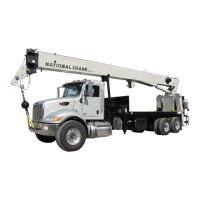
